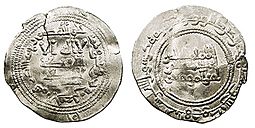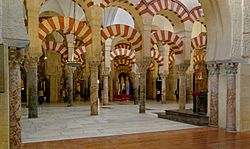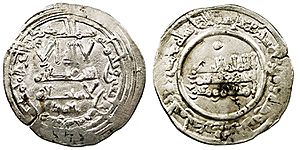Abd al-Rahman III facts for kids
Quick facts for kids Abd al-Rahman III(عبد الرحمن الناصر لدين الله) |
|||||
|---|---|---|---|---|---|
|
|||||

Silver dirham of Abd al-Rahman III minted in 335 AH
|
|||||
| 1st Caliph of Córdoba | |||||
| Reign | 16 January 929 – 15 October 961 | ||||
| Proclamation | 16 January 929 (aged 38) | ||||
| Successor | Al-Hakam II | ||||
| 8th Emir of Córdoba | |||||
| Reign | 16 October 912 – 16 January 929 | ||||
| Bay'ah | 17 October 912 (aged 21) | ||||
| Predecessor | Abdullah | ||||
| Born | 18 December 890 Córdoba |
||||
| Died | 15 October 961 (aged 70) Córdoba |
||||
| Burial | Alcázar of Córdoba | ||||
| Consort | Fatima bint Al-Mundhir Marjan or Murjan (favorite) |
||||
| Issue | Sons in order of birth according to Ibn Hazm: Al-Hakam II (son of Murjan) Abd al-Aziz Al-Asbagh Ubayd Allah Abd al-Jabbar Abd al-Malik Sulayman Abdullah Marwan Al-Mundhir Al-Mugira |
||||
|
|||||
| House | Umayyad; Marwanid (Andalusian) Branch | ||||
| Dynasty | Umayyad | ||||
| Father | Muhammad ibn Abdullah | ||||
| Mother | Muzna (originally Maria?) | ||||
| Religion | Sunni Islam (Maliki school) |
||||
Abd al-Rahman III (890–961) was a powerful ruler from the Umayyad dynasty. He started as the Emir of Córdoba in 912. Later, in 929, he created the Caliphate of Córdoba and became its first caliph.
His long rule, lasting about 50 years, was known for bringing peace and order. He was also famous for allowing different religions to live together peacefully. Abd al-Rahman III earned the special title al-Nasir li-Din Allah, which means "the Defender of God's Faith."
Contents
Life of Abd al-Rahman III
Early Years and Family
Abd al-Rahman was born in Córdoba on December 18, 890. He was the grandson of Abdullah, who was the seventh Umayyad emir of al-Andalus (the Muslim part of Spain). His father was Muhammad, and his mother was Muzna.
He was described as having "white skin, blue eyes, and an attractive face." He was good-looking, though a bit short. He used to dye his reddish-blond beard black.
His Upbringing
Abd al-Rahman spent his early life in the royal palace. His aunt, known as al-Sayyida (meaning "the Lady"), was in charge of his education. She made sure he received a good and strict education. It is believed he even learned the local Mozarabic language, which was spoken by Christians in al-Andalus.
Becoming Ruler
When Emir Abdullah died at age 72, he chose his grandson, Abd al-Rahman III, to be the next ruler. This was a big deal because Abdullah had other sons who could have taken the throne. But Abdullah had always shown special affection for Abd al-Rahman. He even let him live in his own tower and sit on the throne during special events.
On October 16, 912, Abd al-Rahman became the emir, just one day after his grandfather's death. He was about 21 or 22 years old. At that time, the emirate was facing many problems. His power barely reached beyond Córdoba itself.
- To the north, Christian kingdoms were trying to take back land.
- To the south, a new caliphate, the Fatimids, was growing powerful in North Africa.
- Inside al-Andalus, many local families, especially the Muwallads (Muslims of Iberian origin), were rebelling. A strong rebel leader named Umar ibn Hafsun controlled a large part of eastern al-Andalus from his fortress.
Abd al-Rahman was determined to bring order and control back to the emirate. He quickly showed his strong will. Within ten days of becoming ruler, he displayed the head of a rebel leader in Córdoba. He also began leading yearly military trips against rebellious groups to keep them under control. To help him, he brought in saqalibah, who were slaves from Eastern Europe. These new groups helped balance the power between the Arab and Berber people in his court.
Early Rule and Rebellions
For the first 20 years, Abd al-Rahman focused on dealing with the rebels within al-Andalus. He avoided major wars with the Christian kingdoms in the north at first. The Muwallad rebels were his biggest challenge. These powerful families were often supported by people who were secretly Christian. Abd al-Rahman used an army of mercenaries, including Christians, to bring them under control.
His first major goal was to defeat Umar ibn Hafsun. On January 1, 913, his army captured the fortress of Écija, not far from Córdoba. They destroyed most of its defenses.
In the spring, Abd al-Rahman personally led an army to the south. His troops took back areas like Jaén and Granada. He also helped free Málaga from a siege. He continued his campaign, forcing defeated rebels to send hostages and treasures to Córdoba to ensure their loyalty.
He also used rivalries between local lords to gain control. For example, he managed to get the lords of Seville and Carmona to submit to his rule. Seville finally surrendered on December 20, 913.
The region of Valencia peacefully joined his rule in 915.
Defeating Ibn Hafsun
Abd al-Rahman's main goal was to end the long-standing rebellion led by Umar ibn Hafsun. His armies launched several campaigns against Ibn Hafsun and his sons.
Even after Umar ibn Hafsun died in 917, his sons continued the fight. One son, Jaʿfar ibn Hafsun, held the strong city of Toledo. Abd al-Rahman's forces surrounded Toledo for two years. Ja'far tried to get help from Christian kingdoms in the north, but failed. The city finally surrendered on August 2, 932.
The last of Ibn Hafsun's sons, Hafs, commanded his father's powerful fortress. After a six-month siege, Hafs surrendered in 928, and his life was spared.
Becoming Caliph
We are the most worthy to fulfill our right, and the most entitled to complete our good fortune, and to put on the clothing granted by the nobility of God, because of the favour which He has shown us, and the renown which He has given us, and the power to which He has raised us, because of what He has enabled us to acquire, and because of what He has made easy for us and for our state [? dynasty; Arabic: dawla] to achieve; He has made our name and the greatness of our power celebrated everywhere; and He has made the hopes of the worlds depend on us [Arabic: a‘laqa], and made their errings turn again to us and their rejoicing at good news be (rejoicing at good news) about our dynasty [Arabic: dawla]. And praise be to God, possessed of grace and kindness, for the grace which He has shown, [God] most worthy of superiority for the superiority which He has granted us. We have decided that the da‘wa should be to us as Commander of the Faithful and that letters emanating from us or coming to us should be [headed] in the same manner. Everyone who calls himself by this name apart from ourselves is arrogating it to himself [unlawfully] and trespassing upon it and is branded with something to which he has no right. We know that if we were to continue [allowing] the neglect of this duty which is owed to us in this matter then we should be forfeiting our right and neglecting our title, which is certain. So order the khaṭīb in your place to pronounce [the khuṭba] using [this title] and address your communications to us accordingly, if God will. Written on Thursday, 2 Dhū al-Ḥijja 316 [16 January 929].
Even though he hadn't defeated all the rebels, Abd al-Rahman III felt strong enough to make a huge decision. On January 16, 929, he declared himself the Caliph of Córdoba. This meant he was no longer just an emir, but a religious and political leader, like the caliphs in other parts of the Muslim world.
Before this, only rulers of the holy cities of Mecca and Medina were usually called caliphs. But Abd al-Rahman believed his family, the Umayyads, had the right to this title because they had once ruled a vast caliphate. This new title greatly increased his importance and power in al-Andalus and beyond.
As caliph, he became the leader of all Muslims in al-Andalus. He also protected his Christian and Jewish subjects. To show his new power, he used a special sceptre and throne. He also started minting new gold and silver coins with his name on them.
He continued to expand his influence. He gained control over cities like Badajoz and Alcácer do Sal. In North Africa, he built a strong navy to fight against the growing power of the Fatimids. He helped local Berber groups take control of cities like Melilla (927), Ceuta (931), and Tangiers (951). These groups then accepted his rule.
In 951, he made peace with the king of León to focus on the Fatimids, whose ships were causing trouble in the Mediterranean Sea. His forces even attacked the Fatimid port of Tunis, forcing them to pay a large sum of money.
Wars with Christian Kingdoms
Even while dealing with rebels, Abd al-Rahman III also fought against the Christian kingdoms in the north. These kingdoms, like León and Navarre, had taken advantage of the earlier troubles in al-Andalus.
In 917, his army was defeated by King Ordoño II of León at the Battle of San Esteban de Gormaz. Recognizing Ordoño's strength, Abd al-Rahman gathered a larger army. In 920, he defeated King Sancho Garcés I of Navarre and King Ordoño II at the Battle of Valdejunquera. He then marched into Navarre, even reaching and sacking the city of Pamplona.
In 924, he launched another campaign against Sancho in Navarre. He devastated a large area of Basque territory.
After Ordoño II died, there was a struggle for the throne in León. This gave Abd al-Rahman a break from fighting until Ramiro II became king in 932. Ramiro tried to help the rebels in Toledo, but Abd al-Rahman stopped him.
In 934, Abd al-Rahman showed his power over Pamplona and Álava. He forced Ramiro to retreat and made the Navarrese queen, Toda (who was his aunt), accept his authority. In 937, he captured about thirty castles in León.
However, in 939, Ramiro and García of Navarre managed to defeat Abd al-Rahman's army at the Battle of Simancas. After this defeat, Abd al-Rahman no longer personally led his armies into battle. Despite this loss, the Christian kingdoms then faced their own internal conflicts, which helped Abd al-Rahman's cause.
In 950, Abd al-Rahman received a visit from the count of Borrell II of Barcelona. They agreed to peace and mutual support. In 958, King Sancho (who had been exiled), King García Sánchez of Pamplona, and Queen Toda all came to Córdoba to show their respect to Abd al-Rahman.
Until 961, the caliphate played an important role in the power struggles among the Christian kingdoms. Abd al-Rahman helped Sancho the Fat, the exiled king of León, regain his throne in exchange for some castles.
Later Years and Death
Abd al-Rahman spent his final years in his magnificent new palace outside Córdoba. He passed away on October 15, 961. His son, Al-Hakam II, became the next caliph.
Legacy of Abd al-Rahman III
Abd al-Rahman III was a great leader who supported arts and building projects. He used a third of his government's income for building. After becoming caliph, he ordered the construction of a huge palace complex called Medina Azahara, located about five kilometers north of Córdoba. This palace was a symbol of his power and connected him to his Umayyad ancestors.
During his reign, Córdoba became a very important center of learning and culture in Western Europe. He expanded the city's library, which became even greater under his successors.
He also made the Iberian fleet (navy) very strong, making it the most powerful in Mediterranean Europe. Ships from al-Andalus sailed to places like Galicia, Asturias, and North Africa.
Thanks to his strong rule, Muslim Iberia became a major power for several centuries. This also brought great wealth, and he created mints that produced pure gold and silver coins. He also improved and added to the famous Mosque–Cathedral of Córdoba.
He was very careful to keep control and closely managed his family. He was known for being fair to non-Muslims, including Jews and Christians. European kingdoms, like Germany and the Byzantine Empire, even sent their representatives to Córdoba to meet with him.
See also
 In Spanish: Abderramán III para niños
In Spanish: Abderramán III para niños



